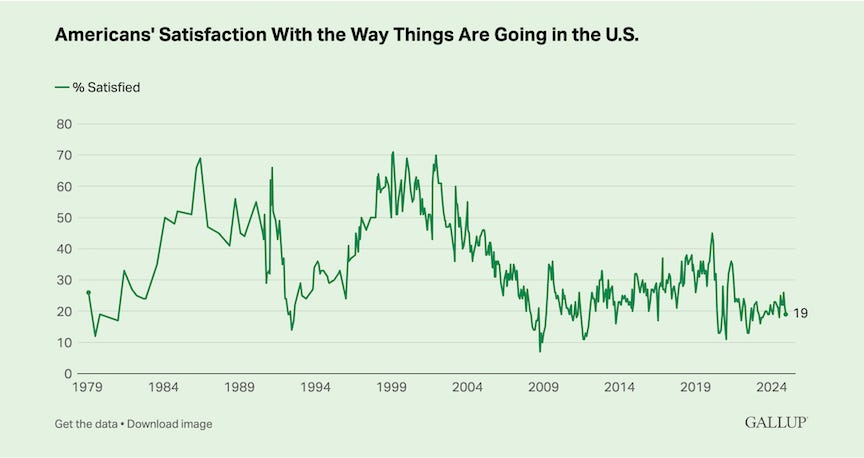Today’s topic was prompted by an interaction with the Bulwark’s Andrew Egger. In the “Morning Shots” newsletter he shares with Bill Krystal, he wrote about declining trust. He noted a Gallup survey that showed people’s levels of trust falling for nearly all occupations except for auto mechanics. He notes:
But what’s most striking about the survey is its overall trend line. Since the year 2000, exactly one profession—auto mechanics—has improved its position in the survey. Across pretty much all of society, trust has only diminished. The starkest drop-offs have clustered around professions with supposed intellectual, legal, or moral authority. Trust in medical doctors and judges have fallen more than 10 percent just since 2021. Clergy, police officers, grade-school teachers, and pharmacists are all down double digits since the early 2000s.
When he shared his insights on BlueSky, I responded that I had written on this late last year. He asked for the link, which I provided. I was thrilled when he then subscribed to this meager newsletter!
I will likely return to this topic in the future and explore more statistical relationships. But today I want to zoom out to the public’s general impression of how we’re doing as a country. Gallup has also regularly asked if people are satisfied or dissatisfied with the state of the country. The question reads “In general, are you satisfied or dissatisfied with the way things are going in the United States at this time?”. The long view of the responses is troubling.
At the beginning of this year, I wrote on the death of President Jimmy Carter and explored some of what he said in what became known (incorrectly) as “the malaise speech”. You can see that spirit of dissatisfaction at the far left of the chart. It wasn’t until the middle of Reagan’s second term that people began feeling good again (“Morning in America”).
Things bottom out next late in the GHW Bush administration and improve through the Clinton administration. Post 9/11 things start heading the wrong direction and bottom out in the Financial Crisis of 2009.
But then the peak and valley pattern stops (or at least shrinks). There are numerous explanation for why things changed (and I hope to explore them in more detail in coming weeks).
Here are a few factors I think could be correlated with people’s dissatisfaction. In the financial crisis, we demonstrated that the financialization of the economy begun by Clinton and the New Democrats meant that the government needed to bail out the financial institutions in order to avoid a full meltdown. No such concern went to homeowners caught up in predatory subprime mortgages; in fact, they were demonized.
Of course, I have to mention Senator Mitch McConnell’s commitment to making Obama a one-term president. Not that there wasn’t partisan obstruction before, but it moved to new levels and became much more intransigent. That opposition now seems to be the Republican party platform.
The rise in partisan divides in attitude and media diet is yet another factor. One of the things I hope to explore going forward is the level of partisan divide on these indices. While the average of the data may stay relatively close to where it has been before, there may be sizable swings depending on which party is in power. Paul Krugman noted this morning that Republicans predict that inflation will be near zero in the future while Democrats expect it to be around 4.5%. I’m certain that those estimates would have been reversed a year ago.
Another factor is that governing is hard (see all of my posts on campaigning versus governing). Dan Pfeiffer had a post this morning evaluating the Biden administration. He notes that there were many initiatives put in place that may pay great dividends down the road, but that the chips factories, bridges, and EV charging stations haven’t come on line yet. I would add that when these to become realities, voters will see them as local accomplishments and ignore how Biden-era legislation got the ball rolling.
Things looked pretty good on the Gallup chart before Covid hit. Then there is a sharp uptick (still under water) before the decline starts again. I would suggest that this was evidence of the government responding to people’s immediate needs with stimulus checks, eviction and student loan pauses, and the child tax credit. Then those ended, which was worse than not ever having support. And the resulting inflationary pressures have been devastating.
For whatever combination of the above, this ongoing dissatisfaction is similar to what Andrew Egger was arguing.
You could chalk this growing cynicism up to any number of factors—a 21st century defined by a sequence of society-shaking crises, the loss of a sense of shared moral code, the growing numbers of people who receive the world primarily through hostile algorithms designed to keep them scared and angry. The more faith we lose in the people around us, the more we pull back from the world, and the more isolated we become, feeding into more distrust.
Things are not likely to get better until the underlying challenges of media, governance, and financial well being are resolved. Our current strategy of deferring to the oligarchs is, I fear, going to make matters much worse. Especially if the new administration adopts a strategy of pitting groups of Americans against other groups of Americans.
Two more updates.
First, there will be no newsletter on Friday. We’re headed to Southern Lights, a gathering in St. Simons, GA hosted by Diana Butler Bass and Brian McClaren with a great panel of speakers and musicians. I’ll write about this next week for sure.
Second, while my book doesn’t officially release until February 13th, advanced copies are now out in the wild! Let me know if you’d like to join the launch group.






See this link for effects of distrust: https://open.substack.com/pub/makeworldbetter/p/fake-patriots-cause-distrust-division?r=4cfvk9&utm_campaign=post&utm_medium=web&showWelcomeOnShare=false